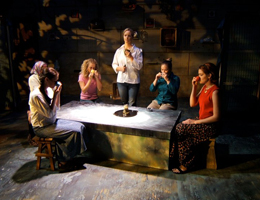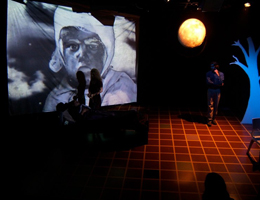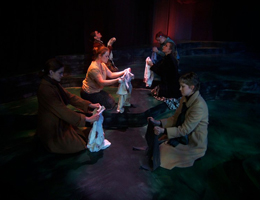Art
October 5-9, 12-16, 2005
Playwright: Yasmina Reza
Translation by: Christopher Hampton
Directed by: Ronal Stepney
Is 200,000 francs too much for a white canvas painting? Can a piece of art destroy friendships? In Yasmina Reza's play Art, friendships are tested all because of one art piece. Art is all about relationships. Relationships are the key. Art examines in depth how relationships are affected by everyday situations and with every choice we make in life. Relationships shine through here, from Serge's deep friendship with Marc, to their relationship with Yvan, to his relationship with his fiance. This piece of art takes these three friends on an intellectual journey and teaches a valuable lesson that forever changes them all. You really can't put a price on friendship. Or can you?
Two American women, a Park Avenue psychiatrist and an ambitious young writer, travel to Bosnia to help women refugees confront their memories of war. Though the two have little in common beyond the methods they use to distance themselves from their subjects, they emerge deeply changed as they confront their own fears in the face of violence, resiliency, and war. Based on interviews conducted by Eve Ensler with numerous women who survived the civil war in the former Yugoslavia, Necessary Targetsis a timely reminder of how America struggles to define its relationship to the rest of the world.
A collection of work by Sam Shepard, Joseph Chaikin, and Heiner Müller.
The story you will see is not a story. It has no beginning, no middle, no end. It has no central character changed by struggles against opposing forces. There is no catharsis here. You will see brief fragments of stories where desire, frustration, connection and autonomy play the chief roles. You will see allegory and metaphor. You will think it is a story of a dying man dreaming of a lost love. But you will soon feel it has to be more than that because of the others. You will settle on themes. One theme in particular will be most evident and that is the human capacity to be satisfied with the state of desiring; desire as an end. You will note that this state exists in and out of the relationships we create whether those relations are interpersonal or international. The form of what you will see is somewhere between pastiche and montage. It is fragmented, multi-layered, disconnected, subjective, and dream-like. In other words, what you will see is real life.
The Women of Lockerbie
March 29-April 2, April 5-9, 2006
Playwright: Deborah Brevoort
Directed by: Diane Stewart
A mother from New Jersey roams the hills of Lockerbie, Scotland, looking for her son's remains that were lost in the crash of Pan Am 103. She meets the women of Lockerbie, who are fighting the U.S. government to obtain the clothing of the victim's found in the plane's wreckage. The women, determined to convert an act of hatred into an act of love, want to wash the clothes of the dead and return them to the victims' families. Written in the structure of a Greek tragedy, it is a poetic drama about the triumph of love over hate.




